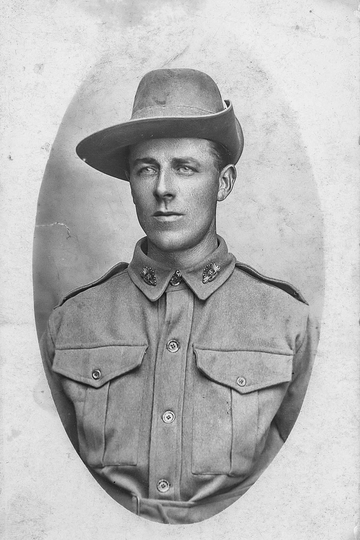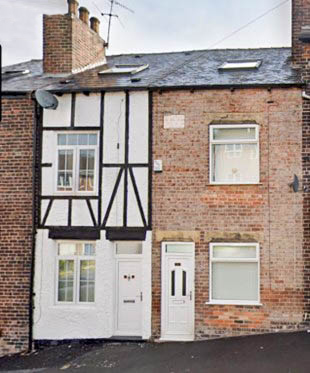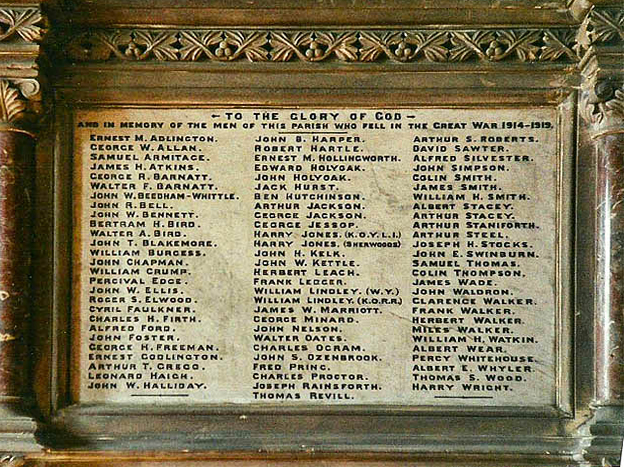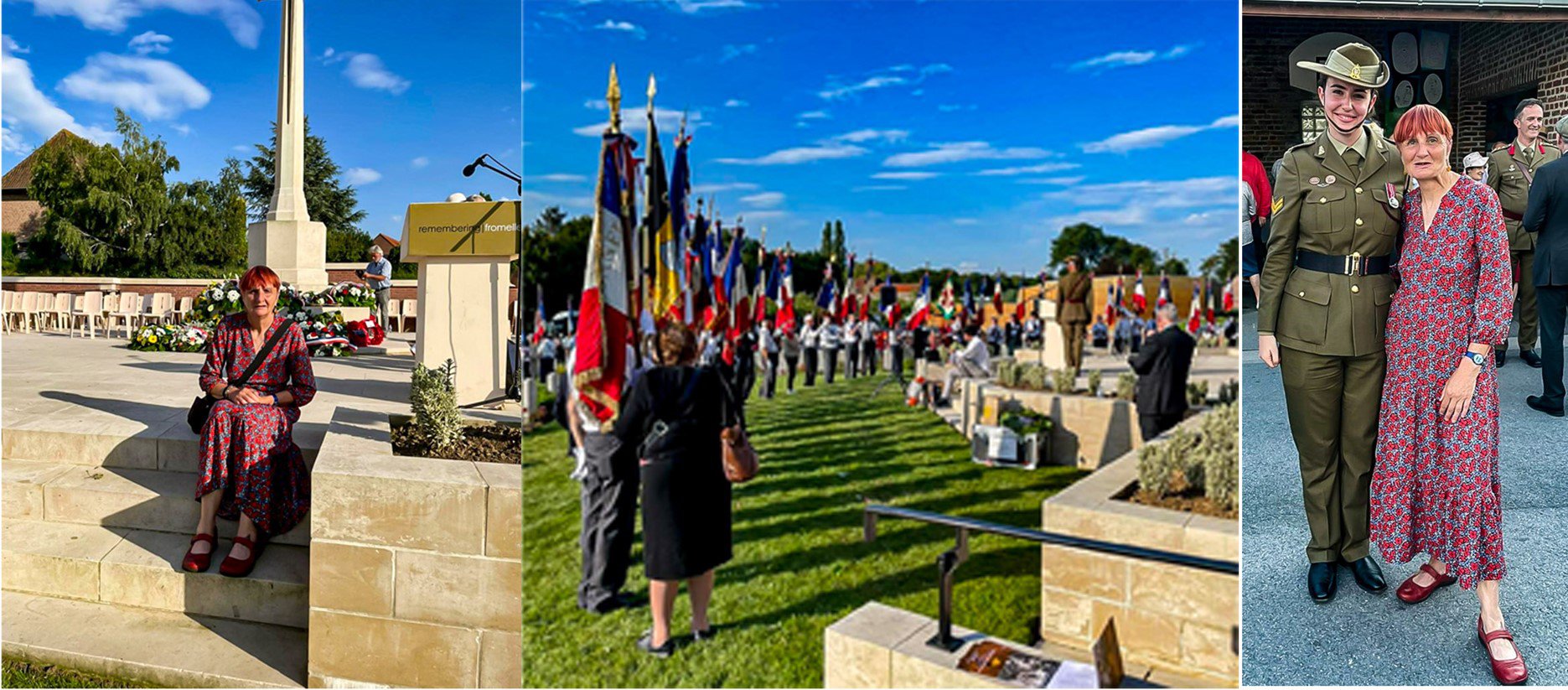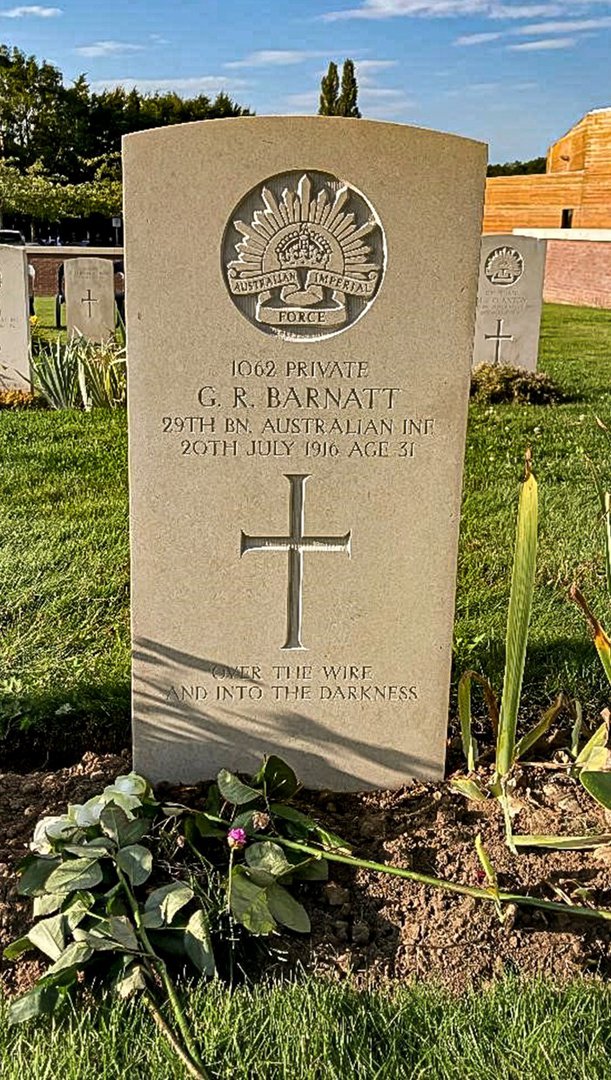George Robert BARNATT
Eyes blue, Hair light brown, Complexion fresh
George Robert Barnatt – Found at Last
Early Life
George Robert Barnatt was born in May 1885 in Gosberton, Lincolnshire, England, a farming area between Nottingham and Norwich. He was the eldest of William and Florence Alice (nee Winters) Barnatt’s seven surviving children:
- George 1885-1916, died Fromelles
- Rose 1888-1975
- Alfred 1889-1953
- Walter 1893-1916 (Royal Field Artillery 1132, died in the Somme)
- Luther Oliver 1897-1943
- Arthur Ernest 1898-1956 (Northumberland Fusiliers 6063)
- Winifred 1911-1953
His father William worked as a farm worker/waggoner. The family must have moved often, as all the children were born in different towns, but all in the same general area. By 1911 William had left farming and was working for the railroads as a platelayer. The family, including 25 year old George, were living at 32 Jardine Street, Wincobank, Sheffield.
George attended ‘Board School’, the national schools, but by the time he was 15 he was working as a farm labourer. When the family settled in Sheffield, he was a labourer in town. George emigrated to Australia with his sister Rose and her husband Thomas "Tom" Senior in 1912. They first arrived in Sydney on the Orama on the 5th December, but continued on and settled in Healesville, Victoria, outside of Melbourne. Both George and Tom worked as farm labourers there.
Off to War
Brothers George , Walter and Arthur as well as Rose’s husband, Tom Senior, all enlisted in mid-1915. Both George (1062) and Tom (1241) joined the Australian Imperial Force on 5 July. Walter the Royal Field Artillery (1132) and Arthur the Northumberland Fusiliers (6063).
George and Tom were assigned to the newly formed 29th Battalion, D Company, and their training began at the Seymour Camp. As the battalion grew they moved to the Broadmeadows Camp. Before departing Australia, the soldiers had been on parade in Melbourne in front of a good crowd and were reviewed by the Minister for Defence, H.F. Pearce, who said:
“I do not think I have ever seen a finer body of men.”
They left for Egypt on 10 November, 1915, sailing on the troopship A11 Ascanius.
Egypt
After a month’s voyage, George and Tom arrived in Suez, Egypt on 7 December. Their assignments included training and defence of the Suez Canal, with postings at Ismailia, Tel el Kebir, Ferry Post and Moascar. While in Tel el Kebir the troops were reviewed by the Prince of Wales.
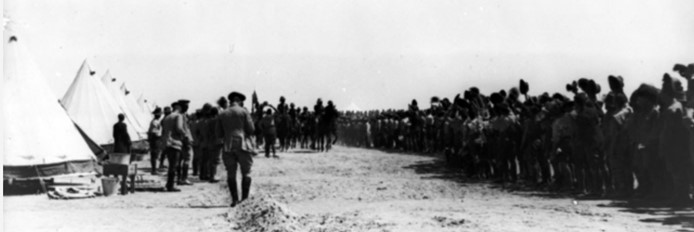
The Western Front
The call to the Western Front came and on 16 June the 29th boarded the troop ship Tunisian in Alexandria. They first headed to Marseilles, arriving there on the 23rd. Then they were on a train to Hazebrouck and Steenbeque and by 26 June were encamped in Morbecque, about 30 km from Fleurbaix. The Aussies were well received by the French. In a letter home, James Lang (858), 29th Battalion from Glengarry, Victoria, wrote:
“The French people lined the streets to see us, and gave us a great welcome. Lots of poor women and young girls started crying. No doubt the poor things were thinking of their own dear ones who had gone to the front.”
On 1 July the 29th moved back to Hazebrouck. Gas masks were now included in their training for the possible use of ‘lachrymatory shells’ – tear gas. Training was tough. One day included a march of 16 miles carrying a 75 lb kit, which only the youngest and fittest could complete. On the 9th July they were moved to Erquingham, just outside of Fleurbaix and on the 10th George and Tom got their first experience in the trenches. The reports noted - ‘men all in good spirits’.
Source AWM4 23/46/12 29th Infantry Battalion July 1916 page 3.
They were back at their billets in Fleurbaix four days later. A gas alarm was sounded on the 15th, but there was no effect on the troops in Fleurbaix.
Battle of Fromelles

The 29th’s role was to be a ‘fourth’ battalion for the left flank of the attack. Along with the 30th, they were to provide support for the attacking 31st and 32nd Battalions by digging trenches, carrying supplies/ammunition and to be called in as reserves if needed for the fighting. The original attack was planned for the 17th, but bad weather caused it to be postponed. On 19 July the 29th were in the rear trenches, ready for the attack.
The 32nd’s charge over the parapet began at 5.53 PM and the 31st’s at 5.58 PM. There were machine gun emplacements to their left and directly ahead at Delrangre Farm and there was heavy artillery fire in No-Man’s-Land. The initial assaults were successful and by 6.30 PM the Aussies were in control of the German’s 1st line system, which was described as:
“practically a ditch with from 1 to 2 feet of mud and slush at the bottom”.
By 9.00 PM, George and Tom’s D Company and A Company began to carry bombs and supplies to the front trenches. The Australians’ left flank was under heavy bombardment with high explosives and shrapnel. Return bombardment support was provided and the 32nd was told “the trenches were to be held at all costs”.
Source AWM4 23/49/12, 32nd Battalion War Diaries, July 1916, page 12
At 10.00 PM, with the 31st and 32nd in the advanced areas, additional support was being requested and George and Tom’s D Company joined in the fighting.
The Germans counter attacked and at 2.00 AM. B and C Companies were now also engaged, continuing to carry supplies and providing cover for soldiers who were retiring from the battle. However:
“After a struggle in No-Man’s Land, the Germans were content to stop at their own trench.”

At 2 O’clock the enemy were counter attacking….
Fighting continued and at 4.00 AM the Germans began an attack from the Australians’ left flank, bombing and advancing into the communications trench. Given the Australian advances that had been made earlier, portions of the rearward trenches had been left almost empty, which then enabled the Germans to be in a position to surround the advanced soldiers.
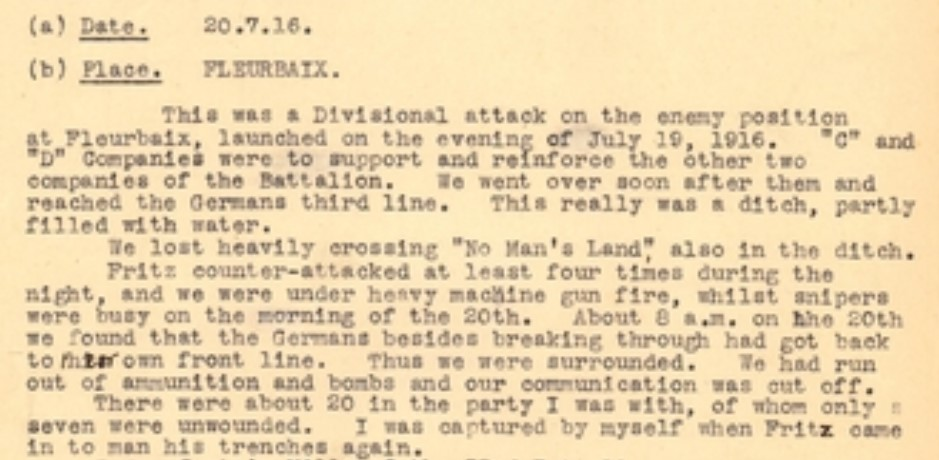
With the Australian attack having been halted, they became exposed in a salient jutting into the German lines and were quickly enfiladed by German machine guns. ‘In the end, they basically had to fight their way back to their own lines, 'run for it', or be killed wounded or captured.’
Source: 29th Battalion VWMA https://vwma.org.au/explore/units/111
In the morning the battle was over. The 29th were left to hold the front line and, even though a cease fire was not in effect, they were busily bringing back a large number of wounded during the day and night.
The nature of this battle was summed up by Private Jim Cleworth (784) from the 29th:
"The novelty of being a soldier wore off in about five seconds, it was like a bloody butcher's shop".
For a battalion supposed to be in a support role, the initial tally of the impact of the battle on the 29th was 17 soldiers died, 161 were wounded and 68 were missing. To get some perspective of the battle, when Charles Bean, Australia’s official war historian, attended the battlefield two and half years later, he observed a large amount of bones, torn uniforms and Australian kit still on the battlefield.
After the Battle
Tom survived the battle, but George was among the missing. As their Company had been called into the fighting at around 10.00 PM, both of them would have been in the advanced area of the attack. There are no reports about what happened to George in his Red Cross file. Nor was he reported as being captured or having his body/ID tags being recovered by the Germans. So, it is not surprising that after the battle he was simply ‘missing’.
A formal review ‘in the field’ on 23 August 1917 finally declared George as having been Killed in Action on 20 July 1916. He was 31 years old.
Tom and Rose went on to have two children and spent their time in England, Canada and Australia. Tom died in 1956 in Seaford, Victoria and Rose returned to England and died in 1975.
Brothers Serving for England
George’s younger brother Walter was in the Royal Field Artillery, 49th West Riding Div. Ammunition Col., and Arthur was in the Northumberland Fusiliers (6063). Walter perhaps would have trained at the Royal School of Artillery on the south edge of the Salisbury plain. He did earn a promotion to corporal.
Sadly, he was killed in action on the Somme four months after George. Arthur survived the War. Walter is commemorated at Redan Ridge Cemetery, No. 2.8.50, which is about 65 km south of Fromelles.
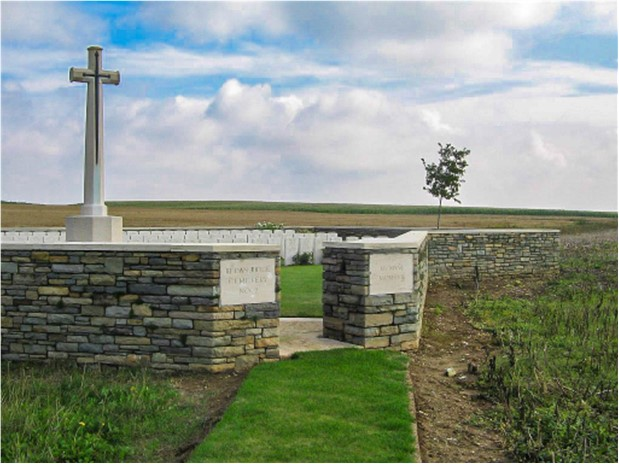
Both George and Walter are commemorated at the St Thomas Church in Wincobank, Sheffield, which is near their family’s home.
George is found at last.
While there are no specifics about what happened to George during/after the battle, his Army file does have a very brief, undated annotation about him being buried at Fromelles, along with some very general map coordinates which are in the area of the Pheasant Wood German burial pit that was found in 2008.
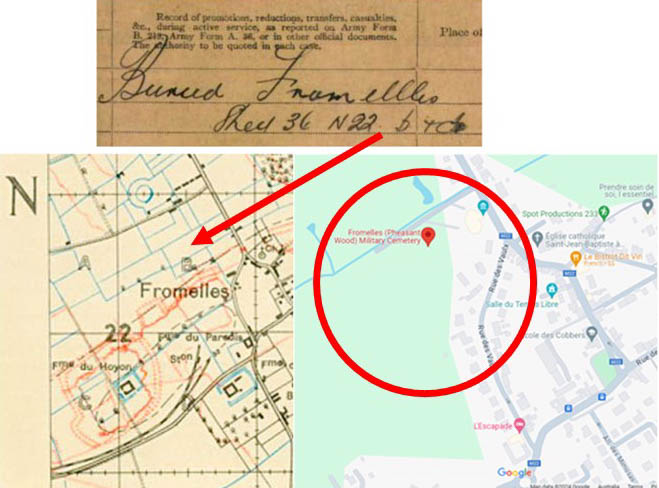
It is unknown how this information came to be associated with George (and there are other soldiers with similar comments in their files), but it does open the possibility that others with this reference could be unidentified soldiers in the burial pit. Other soldiers with this reference location have been discovered at Pheasant Wood including Ernest Frank Wilkin 1314, Gordon Thomas Smith 1245, James Hugh Ross 1215, Thomas William Francis 2584, and David Frederick Livingston 1168.
James Gordon Charles Downie 1097 and Leslie Frederick Kennedy 2677 have the same wording but are yet to be discovered.
On 23 April 2024, the Honourable Minister for Veteran Affairs and Minister for Defence Personnel, Matt Keogh MP, announced that DNA testing has proven that George was identified as being one of the soldiers who was in the mass grave. 180 of the 250 soldiers in the grave, which includes 22 of the 37 originally unidentified soldiers from the 29th Battalion, have been identified from the Pheasant Wood burial site.

Petula Collier, George’s grandniece, was able to attend the reinterment ceremony in July with her cousin Kevin.
“The day went in a whirl. I was totally moved by the whole occasion, from the local village people all attending, to the children who accompanied me to lay roses.
It was so good to be able to attend and up until the bus ride to the first memorial I had never seen a photo of my great uncle. It was good to finally put a face to the name.
Everyone was so helpful and the tour of the museum and seeing my great uncle’s story on the wall about him and his brothers and brother-in-law put everything into context. I really enjoyed the tour of the museum and was moved by the kindness of everyone.
Unfortunately, I was overwhelmed by the heat and had to receive first aid. But I managed to be able to unveil the headstone, at which point I was reduced to tears. Had my mother not died two years before, it would have been her honour. It’s finally given me the answers my mum had about her family and what happened to them.”
The Fromelles Association would love to hear from you

Contacts
(Contact: royce@fromelles.info or geoffrey@fromelles.info).
(Contact: army.uwc@defence.gov.au or phone 1800 019 090).
Donations
If you are able, please contribute to the upkeep of this resource.
(Contact: bill@fromelles.info ).
